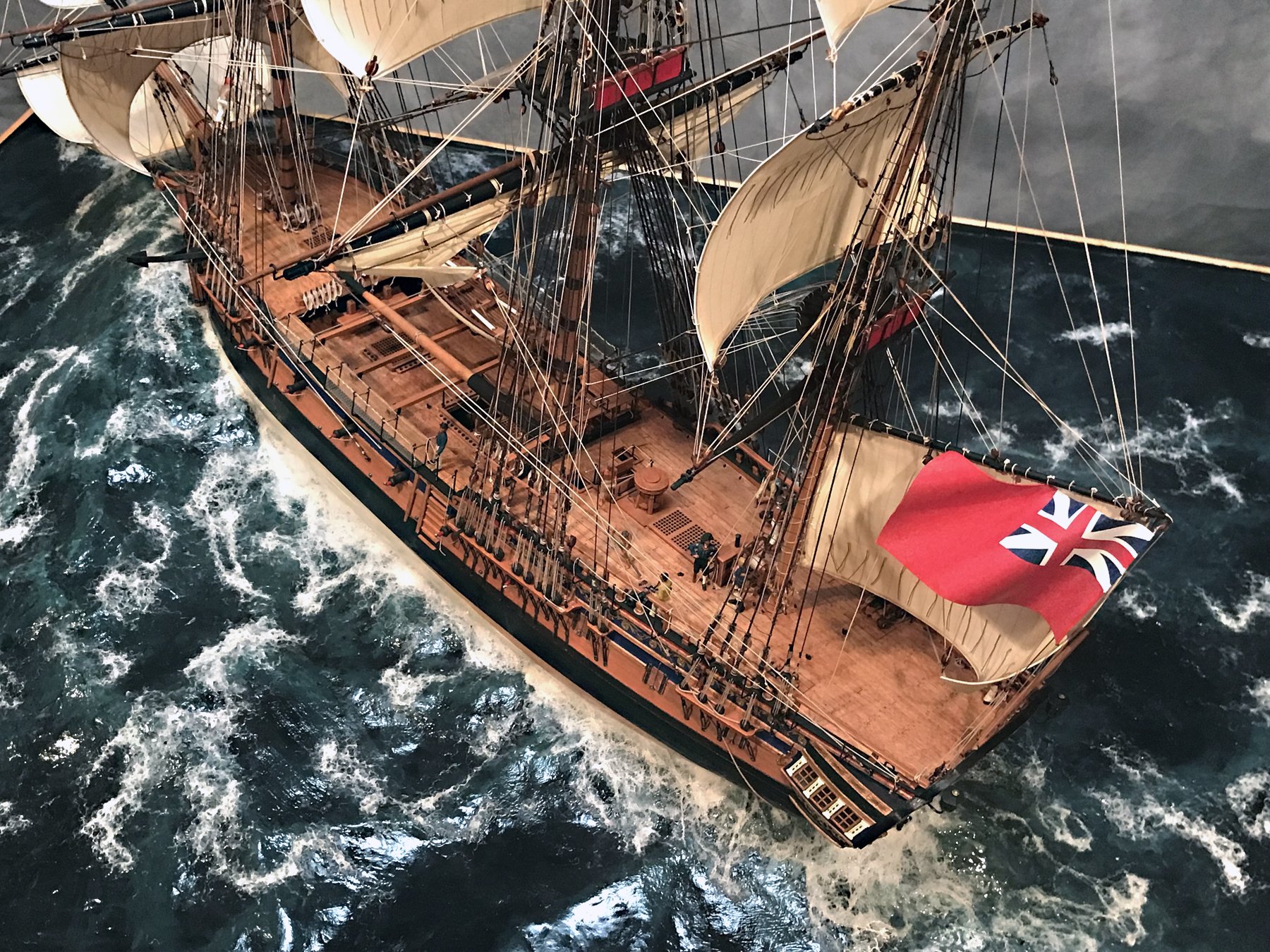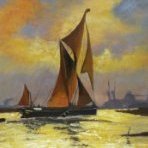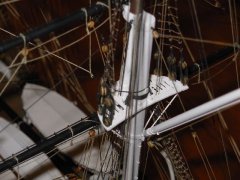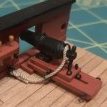Supplies of the Ship Modeler's Handbook are running out. Get your copy NOW before they are gone! Click on photo to order.
×
-
Posts
1,545 -
Joined
-
Last visited
Reputation Activity
-
 hollowneck got a reaction from cotrecerf in HMS Sphinx 1775 by Hollowneck - FINISHED - Vanguard Models - 1:64
hollowneck got a reaction from cotrecerf in HMS Sphinx 1775 by Hollowneck - FINISHED - Vanguard Models - 1:64
Some background on HMS Camilla.
Note that the painting shown here is for HMS Camilla, in 1796 , by artist John Thomas Serres
"HMS Camilla was a Royal Navy 20-gun Sphinx-class post ship. Camilla was built in Chatham Dockyard to a design by John Williams and was launched in 1776. She served in the American Revolution, the French Revolutionary Wars, and the Napoleonic Wars, before being sold in 1831."
That's about 55 years! But who's counting? Extraordinary service by the standards of any nautical era I know about.
"Camilla was commissioned in May 1776 and sailed for North America in August. There she captured the privateer schooner Independence, John Gill, Master, of six carriage guns, eight swivels, and 50 men. She was on a cruise from Boston.Camilla also captured Admiral Montague, sailing from Hispaniola to Rhode Island with a cargo of molasses and coffee, a chance sailing to Georgia with coffee, and Polly, sailing to Surinam in ballast."
Loads of info on HMS Camilla here where the above has been researched : https://en.wikipedia.org/wiki/HMS_Camilla_(1776)
-
 hollowneck got a reaction from mtaylor in HMS Sphinx 1775 by Hollowneck - FINISHED - Vanguard Models - 1:64
hollowneck got a reaction from mtaylor in HMS Sphinx 1775 by Hollowneck - FINISHED - Vanguard Models - 1:64
Thanks, Thukydides.
Sails I expect will happen around late December/January since I anticipate masting and rigging will commence sometime late this month. Diorama in mid-February/March, if I'm lucky. I'm planning for the diorama now, but I'll explain preliminary thinking for the presentation "case" reasonably soon as I think about how the sails will be deployed, the bearing of the ship and how it will appear in the water (degree of list and roll - pitch and yaw to pilots - which partially determines the dimensions of the base). I even have thought about the weather that this ship diorama will present. How's that for a little bit of Crazy, huh?
Ron
-
 hollowneck got a reaction from Malcolm Greig in HMS Sphinx 1775 by Hollowneck - FINISHED - Vanguard Models - 1:64
hollowneck got a reaction from Malcolm Greig in HMS Sphinx 1775 by Hollowneck - FINISHED - Vanguard Models - 1:64
Since I'm playing "catch-up" with my postings I'll mention that these first Build Log photos are NOT SEQUENTIAL. Obviously, I've spent a number of hours getting to point A (the first photo-😁)...and these photos I'll explain, but there may be random "backtracks" as I continue here.
The Gratings and the companionway close-up: the purpose here is highlighting the little black beads that simulate cannonballs which are a nice scale-accurate (or close to it) inclusion in the kit's "fittings" box. The little balls were too shiny for me; my 5 yo granddaughter asked me: "Gampy, where did you get those cute little beads?"...uh... Good question, out of the mouth of babes. So I went back painted all of them FLAT BLACK MATTE. Just a tiny touch to each with a small brush. They now look like iron balls and not something random one finds in the beading aisle at Joanne's Fabrics. Not a big deal, but we collectively agonize over minor stuff like this; it's sort of what this hobby is all about- sort of. You don't need to look too close to see the ordnance as they appear in shiny bead black.
Next photo, a close-up of deck goodies showing: A. a breech-rigged cannon; B. how I've finished my upper interior bulwarks (with the kit's included spirketting and laser cut deck clamp pieces); C. the hanging knees behind the quarterdeck beams; and D. the pump's iron fittings (also in flat black matte paint to show proper - non rusted - iron) and mid-deck bitts and a partial companionway (with the little "beads").
I am often asked how I get the nice warm look to most of my period models. Nothing unusual here: four shades of Minwax, available at Lowe's. Natural, (my favorite for most quality hardwoods I use and the extensive amount of pear that's included in this kit; Golden Oak for areas that I want to appear darker than the warm pink hue of pear and simulate a more accurate color for oak; Weathered Oak whose name speaks for itself. I used this on this kit's maple, one-piece deck patterns ("patterns" is a general name Vanguard gives to many pre-cut, precision lasered items in this kit). I've applied this stain to the gun deck. I may apply a "second coat" before I button-up everything amidships. A can not shown ( I misplaced it, somewhere...), Chestnut stain. This color I use on my deadeyes and most rigging blocks. I understand chestnut was used extensively by the British navy for this purpose - along with lignum vitae pulleys, both purpose-suited because of their inherent hardness. I'll stain my deadeyes soon, before they get mounted in their iron chains.
It should be noted that I paint and stain all my modeling components as I build. I am constantly opening and closing various jars and cans as I build. Simply stated, I make "aesthetic decisions" as I work; these are typically about color of individual component finishes - like cannon balls! I also depart quite often from proscribed building steps for a host of reasons which should become apparent as I develop this log. I need to mention that the build manual and the extensive plans that come with this kit are excellent and generally-speaking, the construction steps are sequenced in a manner that most will appreciate, especially intermediate level modelers.
Lastly, the tools I use to remove "char" from all the laser-cut wood in the kit. I've probably spent 60 hours alone (so far) removing "Char."🤯
My tools for this boring, but essential task: lots of emery/nail sanding files I buy at beauty supply stores. They last forever. But I buy new ones often as I frequently wash them and they soften and go limp after a while. Everyone knows there's not a lot you can do with a limp file.
When I'm de-charing, I often slap the file on my jeans (don't tell my wife) to unpack the fine sanding dust. Works. But they do eventually need to be taken to the sink. Moving on, two from my set of diamond-encrusted mini-files shown here. The tapered round one is especially useful. Worth the money. My soft, sable hair brush. The brush I continually use on all the various surfaces of the model for clean-up as I build. It is helpful to dust the char off tiny pieces like the miniscule hanging knees shown here. The curved stem piece appears to cast a shadow; actually that's the very dark "char" that needs to be diligently removed. Goodbye Char!
And, yes. I did leave it on all my cannon carriage wheels. Good idea, Jim! The manual says this is an option. I obviously agree.
More to come....
-
 hollowneck got a reaction from AJohnson in HMS Sphinx 1775 by Hollowneck - FINISHED - Vanguard Models - 1:64
hollowneck got a reaction from AJohnson in HMS Sphinx 1775 by Hollowneck - FINISHED - Vanguard Models - 1:64
I am starting this Build Log midway in this very interesting and fun project. I'll start with a photo of my overall progress and then there will be the normal, very specific photos about build details I'd like to share with the reader's of this thread.
The first thing that I should note is that I am building this model as a sister ship to the Sphinx, HMS Camilla - same era. I have posted an earlier Kit Review of this Vanguard model that covered my early impressions which I can now amplify as well as offer additional insights as I've moved along on my build. I hope the followers of this thread will think it helpful; that is certainly my intention!
Here we go...
-
 hollowneck got a reaction from Cjames in HMS Sphinx 1775 by Hollowneck - FINISHED - Vanguard Models - 1:64
hollowneck got a reaction from Cjames in HMS Sphinx 1775 by Hollowneck - FINISHED - Vanguard Models - 1:64
More photos, explanations as follows...I'll call this set "Drilling and sawing"...necessities.
The rigging pulleys ( I believe the braces) along the bulwark sides (2 places, each side) do align nicely with the built-up woodwork, but I chose to run a drill through them so that there is free clearance when it comes to rigging. Getting the line through the pulley UNDER the shroud stool will be lots o' fun!
First. drilling the catheads. Although not detailed in the manual, I know that when rigging rears it's head, I'll want to have the anchors trussed-up nicely near the cathead weighing lines. Good idea to have rope passing through the cathead for this. The small, cleverly built-up pieces have photo-etched tiny holes that...uh, go nowhere. That is, until I took my #72 thumb drill (.61mm dia) and pierced all six holes (love these little buggers). Make sure to drill on a flat surface and hold your drill as perpendicular as you can since it's easy to miss and drill off center, which would not be good.*
*Ignore this commentary should you be building the Sphinx kit as an "admiralty-styled" model without rigging, which I suspect some will do as it is designed at least partially for this specific modeling approach.
By test fitting the catheads into the foc'sle surround you'll quickly see that the "openings" for mounting these to the deck are inadequate and rather than try to coax an opening to fit the cathead into the bulwarks through via a square hole with a file and X-acto knife, I decided to saw a tight-fitting slot from the top nearly all the way down to the deck surface. Some may already note that there are TWO (2) additional wrap-around pear wood pieces that must also be mounted to this bulwark arrangement (to basically thicken it). These will also need the "slice" in order to accommodate the cathead(s). Shown here: the starboard cathead is temporarily plugged into place (purposeful tight tolerance here) and the port side shows the opening I've made for each. Be careful to not saw down too far on the exterior of the prow. I did pop-out the corresponding S & P gunwales to check that the depth-of-mounting for the steeply-angled catheads would be adequate to sit below this finishing pattern provided as a single, long piece (both sides). I'll see very soon how the cathead's external supports mate-up and meet as they should.
There is some tricky modifying here to both the PLYWOOD as well as pear patterns; I have no idea why one would try to fiddle this area by opening the square holes to allow the catheads to fall into place properly (through three separate stacked pieces, on each side). Perhaps I'm missing something here, but when holding the gunwales to their respective mounting positions, the fit of the cathead to the deck and below the gunwale looks fine to me: no gaps, weird, wrong angles, etc.
-
 hollowneck got a reaction from EricWilliamMarshall in HMS Sphinx 1775 by Hollowneck - FINISHED - Vanguard Models - 1:64
hollowneck got a reaction from EricWilliamMarshall in HMS Sphinx 1775 by Hollowneck - FINISHED - Vanguard Models - 1:64
Since I'm playing "catch-up" with my postings I'll mention that these first Build Log photos are NOT SEQUENTIAL. Obviously, I've spent a number of hours getting to point A (the first photo-😁)...and these photos I'll explain, but there may be random "backtracks" as I continue here.
The Gratings and the companionway close-up: the purpose here is highlighting the little black beads that simulate cannonballs which are a nice scale-accurate (or close to it) inclusion in the kit's "fittings" box. The little balls were too shiny for me; my 5 yo granddaughter asked me: "Gampy, where did you get those cute little beads?"...uh... Good question, out of the mouth of babes. So I went back painted all of them FLAT BLACK MATTE. Just a tiny touch to each with a small brush. They now look like iron balls and not something random one finds in the beading aisle at Joanne's Fabrics. Not a big deal, but we collectively agonize over minor stuff like this; it's sort of what this hobby is all about- sort of. You don't need to look too close to see the ordnance as they appear in shiny bead black.
Next photo, a close-up of deck goodies showing: A. a breech-rigged cannon; B. how I've finished my upper interior bulwarks (with the kit's included spirketting and laser cut deck clamp pieces); C. the hanging knees behind the quarterdeck beams; and D. the pump's iron fittings (also in flat black matte paint to show proper - non rusted - iron) and mid-deck bitts and a partial companionway (with the little "beads").
I am often asked how I get the nice warm look to most of my period models. Nothing unusual here: four shades of Minwax, available at Lowe's. Natural, (my favorite for most quality hardwoods I use and the extensive amount of pear that's included in this kit; Golden Oak for areas that I want to appear darker than the warm pink hue of pear and simulate a more accurate color for oak; Weathered Oak whose name speaks for itself. I used this on this kit's maple, one-piece deck patterns ("patterns" is a general name Vanguard gives to many pre-cut, precision lasered items in this kit). I've applied this stain to the gun deck. I may apply a "second coat" before I button-up everything amidships. A can not shown ( I misplaced it, somewhere...), Chestnut stain. This color I use on my deadeyes and most rigging blocks. I understand chestnut was used extensively by the British navy for this purpose - along with lignum vitae pulleys, both purpose-suited because of their inherent hardness. I'll stain my deadeyes soon, before they get mounted in their iron chains.
It should be noted that I paint and stain all my modeling components as I build. I am constantly opening and closing various jars and cans as I build. Simply stated, I make "aesthetic decisions" as I work; these are typically about color of individual component finishes - like cannon balls! I also depart quite often from proscribed building steps for a host of reasons which should become apparent as I develop this log. I need to mention that the build manual and the extensive plans that come with this kit are excellent and generally-speaking, the construction steps are sequenced in a manner that most will appreciate, especially intermediate level modelers.
Lastly, the tools I use to remove "char" from all the laser-cut wood in the kit. I've probably spent 60 hours alone (so far) removing "Char."🤯
My tools for this boring, but essential task: lots of emery/nail sanding files I buy at beauty supply stores. They last forever. But I buy new ones often as I frequently wash them and they soften and go limp after a while. Everyone knows there's not a lot you can do with a limp file.
When I'm de-charing, I often slap the file on my jeans (don't tell my wife) to unpack the fine sanding dust. Works. But they do eventually need to be taken to the sink. Moving on, two from my set of diamond-encrusted mini-files shown here. The tapered round one is especially useful. Worth the money. My soft, sable hair brush. The brush I continually use on all the various surfaces of the model for clean-up as I build. It is helpful to dust the char off tiny pieces like the miniscule hanging knees shown here. The curved stem piece appears to cast a shadow; actually that's the very dark "char" that needs to be diligently removed. Goodbye Char!
And, yes. I did leave it on all my cannon carriage wheels. Good idea, Jim! The manual says this is an option. I obviously agree.
More to come....
-
 hollowneck got a reaction from EricWilliamMarshall in HMS Sphinx 1775 by Hollowneck - FINISHED - Vanguard Models - 1:64
hollowneck got a reaction from EricWilliamMarshall in HMS Sphinx 1775 by Hollowneck - FINISHED - Vanguard Models - 1:64
Some background on HMS Camilla.
Note that the painting shown here is for HMS Camilla, in 1796 , by artist John Thomas Serres
"HMS Camilla was a Royal Navy 20-gun Sphinx-class post ship. Camilla was built in Chatham Dockyard to a design by John Williams and was launched in 1776. She served in the American Revolution, the French Revolutionary Wars, and the Napoleonic Wars, before being sold in 1831."
That's about 55 years! But who's counting? Extraordinary service by the standards of any nautical era I know about.
"Camilla was commissioned in May 1776 and sailed for North America in August. There she captured the privateer schooner Independence, John Gill, Master, of six carriage guns, eight swivels, and 50 men. She was on a cruise from Boston.Camilla also captured Admiral Montague, sailing from Hispaniola to Rhode Island with a cargo of molasses and coffee, a chance sailing to Georgia with coffee, and Polly, sailing to Surinam in ballast."
Loads of info on HMS Camilla here where the above has been researched : https://en.wikipedia.org/wiki/HMS_Camilla_(1776)
-
 hollowneck got a reaction from Canute in HMS Sphinx 1775 by Hollowneck - FINISHED - Vanguard Models - 1:64
hollowneck got a reaction from Canute in HMS Sphinx 1775 by Hollowneck - FINISHED - Vanguard Models - 1:64
Mike.
Fixed. Thanks, I knew that.🤫
Ron
-
 hollowneck got a reaction from etubino in HMS Sphinx 1775 by Hollowneck - FINISHED - Vanguard Models - 1:64
hollowneck got a reaction from etubino in HMS Sphinx 1775 by Hollowneck - FINISHED - Vanguard Models - 1:64
I am starting this Build Log midway in this very interesting and fun project. I'll start with a photo of my overall progress and then there will be the normal, very specific photos about build details I'd like to share with the reader's of this thread.
The first thing that I should note is that I am building this model as a sister ship to the Sphinx, HMS Camilla - same era. I have posted an earlier Kit Review of this Vanguard model that covered my early impressions which I can now amplify as well as offer additional insights as I've moved along on my build. I hope the followers of this thread will think it helpful; that is certainly my intention!
Here we go...
-
 hollowneck got a reaction from GrandpaPhil in HMS Sphinx 1775 by Hollowneck - FINISHED - Vanguard Models - 1:64
hollowneck got a reaction from GrandpaPhil in HMS Sphinx 1775 by Hollowneck - FINISHED - Vanguard Models - 1:64
Since I'm playing "catch-up" with my postings I'll mention that these first Build Log photos are NOT SEQUENTIAL. Obviously, I've spent a number of hours getting to point A (the first photo-😁)...and these photos I'll explain, but there may be random "backtracks" as I continue here.
The Gratings and the companionway close-up: the purpose here is highlighting the little black beads that simulate cannonballs which are a nice scale-accurate (or close to it) inclusion in the kit's "fittings" box. The little balls were too shiny for me; my 5 yo granddaughter asked me: "Gampy, where did you get those cute little beads?"...uh... Good question, out of the mouth of babes. So I went back painted all of them FLAT BLACK MATTE. Just a tiny touch to each with a small brush. They now look like iron balls and not something random one finds in the beading aisle at Joanne's Fabrics. Not a big deal, but we collectively agonize over minor stuff like this; it's sort of what this hobby is all about- sort of. You don't need to look too close to see the ordnance as they appear in shiny bead black.
Next photo, a close-up of deck goodies showing: A. a breech-rigged cannon; B. how I've finished my upper interior bulwarks (with the kit's included spirketting and laser cut deck clamp pieces); C. the hanging knees behind the quarterdeck beams; and D. the pump's iron fittings (also in flat black matte paint to show proper - non rusted - iron) and mid-deck bitts and a partial companionway (with the little "beads").
I am often asked how I get the nice warm look to most of my period models. Nothing unusual here: four shades of Minwax, available at Lowe's. Natural, (my favorite for most quality hardwoods I use and the extensive amount of pear that's included in this kit; Golden Oak for areas that I want to appear darker than the warm pink hue of pear and simulate a more accurate color for oak; Weathered Oak whose name speaks for itself. I used this on this kit's maple, one-piece deck patterns ("patterns" is a general name Vanguard gives to many pre-cut, precision lasered items in this kit). I've applied this stain to the gun deck. I may apply a "second coat" before I button-up everything amidships. A can not shown ( I misplaced it, somewhere...), Chestnut stain. This color I use on my deadeyes and most rigging blocks. I understand chestnut was used extensively by the British navy for this purpose - along with lignum vitae pulleys, both purpose-suited because of their inherent hardness. I'll stain my deadeyes soon, before they get mounted in their iron chains.
It should be noted that I paint and stain all my modeling components as I build. I am constantly opening and closing various jars and cans as I build. Simply stated, I make "aesthetic decisions" as I work; these are typically about color of individual component finishes - like cannon balls! I also depart quite often from proscribed building steps for a host of reasons which should become apparent as I develop this log. I need to mention that the build manual and the extensive plans that come with this kit are excellent and generally-speaking, the construction steps are sequenced in a manner that most will appreciate, especially intermediate level modelers.
Lastly, the tools I use to remove "char" from all the laser-cut wood in the kit. I've probably spent 60 hours alone (so far) removing "Char."🤯
My tools for this boring, but essential task: lots of emery/nail sanding files I buy at beauty supply stores. They last forever. But I buy new ones often as I frequently wash them and they soften and go limp after a while. Everyone knows there's not a lot you can do with a limp file.
When I'm de-charing, I often slap the file on my jeans (don't tell my wife) to unpack the fine sanding dust. Works. But they do eventually need to be taken to the sink. Moving on, two from my set of diamond-encrusted mini-files shown here. The tapered round one is especially useful. Worth the money. My soft, sable hair brush. The brush I continually use on all the various surfaces of the model for clean-up as I build. It is helpful to dust the char off tiny pieces like the miniscule hanging knees shown here. The curved stem piece appears to cast a shadow; actually that's the very dark "char" that needs to be diligently removed. Goodbye Char!
And, yes. I did leave it on all my cannon carriage wheels. Good idea, Jim! The manual says this is an option. I obviously agree.
More to come....
-
 hollowneck got a reaction from BobG in HMS Sphinx 1775 by Hollowneck - FINISHED - Vanguard Models - 1:64
hollowneck got a reaction from BobG in HMS Sphinx 1775 by Hollowneck - FINISHED - Vanguard Models - 1:64
Thanks, Thukydides.
Sails I expect will happen around late December/January since I anticipate masting and rigging will commence sometime late this month. Diorama in mid-February/March, if I'm lucky. I'm planning for the diorama now, but I'll explain preliminary thinking for the presentation "case" reasonably soon as I think about how the sails will be deployed, the bearing of the ship and how it will appear in the water (degree of list and roll - pitch and yaw to pilots - which partially determines the dimensions of the base). I even have thought about the weather that this ship diorama will present. How's that for a little bit of Crazy, huh?
Ron
-
 hollowneck got a reaction from GrandpaPhil in HMS Sphinx 1775 by Hollowneck - FINISHED - Vanguard Models - 1:64
hollowneck got a reaction from GrandpaPhil in HMS Sphinx 1775 by Hollowneck - FINISHED - Vanguard Models - 1:64
Some background on HMS Camilla.
Note that the painting shown here is for HMS Camilla, in 1796 , by artist John Thomas Serres
"HMS Camilla was a Royal Navy 20-gun Sphinx-class post ship. Camilla was built in Chatham Dockyard to a design by John Williams and was launched in 1776. She served in the American Revolution, the French Revolutionary Wars, and the Napoleonic Wars, before being sold in 1831."
That's about 55 years! But who's counting? Extraordinary service by the standards of any nautical era I know about.
"Camilla was commissioned in May 1776 and sailed for North America in August. There she captured the privateer schooner Independence, John Gill, Master, of six carriage guns, eight swivels, and 50 men. She was on a cruise from Boston.Camilla also captured Admiral Montague, sailing from Hispaniola to Rhode Island with a cargo of molasses and coffee, a chance sailing to Georgia with coffee, and Polly, sailing to Surinam in ballast."
Loads of info on HMS Camilla here where the above has been researched : https://en.wikipedia.org/wiki/HMS_Camilla_(1776)
-
 hollowneck got a reaction from Canute in HMS Sphinx 1775 by Hollowneck - FINISHED - Vanguard Models - 1:64
hollowneck got a reaction from Canute in HMS Sphinx 1775 by Hollowneck - FINISHED - Vanguard Models - 1:64
Some background on HMS Camilla.
Note that the painting shown here is for HMS Camilla, in 1796 , by artist John Thomas Serres
"HMS Camilla was a Royal Navy 20-gun Sphinx-class post ship. Camilla was built in Chatham Dockyard to a design by John Williams and was launched in 1776. She served in the American Revolution, the French Revolutionary Wars, and the Napoleonic Wars, before being sold in 1831."
That's about 55 years! But who's counting? Extraordinary service by the standards of any nautical era I know about.
"Camilla was commissioned in May 1776 and sailed for North America in August. There she captured the privateer schooner Independence, John Gill, Master, of six carriage guns, eight swivels, and 50 men. She was on a cruise from Boston.Camilla also captured Admiral Montague, sailing from Hispaniola to Rhode Island with a cargo of molasses and coffee, a chance sailing to Georgia with coffee, and Polly, sailing to Surinam in ballast."
Loads of info on HMS Camilla here where the above has been researched : https://en.wikipedia.org/wiki/HMS_Camilla_(1776)
-
 hollowneck got a reaction from Ryland Craze in HMS Sphinx 1775 by Hollowneck - FINISHED - Vanguard Models - 1:64
hollowneck got a reaction from Ryland Craze in HMS Sphinx 1775 by Hollowneck - FINISHED - Vanguard Models - 1:64
Since I'm playing "catch-up" with my postings I'll mention that these first Build Log photos are NOT SEQUENTIAL. Obviously, I've spent a number of hours getting to point A (the first photo-😁)...and these photos I'll explain, but there may be random "backtracks" as I continue here.
The Gratings and the companionway close-up: the purpose here is highlighting the little black beads that simulate cannonballs which are a nice scale-accurate (or close to it) inclusion in the kit's "fittings" box. The little balls were too shiny for me; my 5 yo granddaughter asked me: "Gampy, where did you get those cute little beads?"...uh... Good question, out of the mouth of babes. So I went back painted all of them FLAT BLACK MATTE. Just a tiny touch to each with a small brush. They now look like iron balls and not something random one finds in the beading aisle at Joanne's Fabrics. Not a big deal, but we collectively agonize over minor stuff like this; it's sort of what this hobby is all about- sort of. You don't need to look too close to see the ordnance as they appear in shiny bead black.
Next photo, a close-up of deck goodies showing: A. a breech-rigged cannon; B. how I've finished my upper interior bulwarks (with the kit's included spirketting and laser cut deck clamp pieces); C. the hanging knees behind the quarterdeck beams; and D. the pump's iron fittings (also in flat black matte paint to show proper - non rusted - iron) and mid-deck bitts and a partial companionway (with the little "beads").
I am often asked how I get the nice warm look to most of my period models. Nothing unusual here: four shades of Minwax, available at Lowe's. Natural, (my favorite for most quality hardwoods I use and the extensive amount of pear that's included in this kit; Golden Oak for areas that I want to appear darker than the warm pink hue of pear and simulate a more accurate color for oak; Weathered Oak whose name speaks for itself. I used this on this kit's maple, one-piece deck patterns ("patterns" is a general name Vanguard gives to many pre-cut, precision lasered items in this kit). I've applied this stain to the gun deck. I may apply a "second coat" before I button-up everything amidships. A can not shown ( I misplaced it, somewhere...), Chestnut stain. This color I use on my deadeyes and most rigging blocks. I understand chestnut was used extensively by the British navy for this purpose - along with lignum vitae pulleys, both purpose-suited because of their inherent hardness. I'll stain my deadeyes soon, before they get mounted in their iron chains.
It should be noted that I paint and stain all my modeling components as I build. I am constantly opening and closing various jars and cans as I build. Simply stated, I make "aesthetic decisions" as I work; these are typically about color of individual component finishes - like cannon balls! I also depart quite often from proscribed building steps for a host of reasons which should become apparent as I develop this log. I need to mention that the build manual and the extensive plans that come with this kit are excellent and generally-speaking, the construction steps are sequenced in a manner that most will appreciate, especially intermediate level modelers.
Lastly, the tools I use to remove "char" from all the laser-cut wood in the kit. I've probably spent 60 hours alone (so far) removing "Char."🤯
My tools for this boring, but essential task: lots of emery/nail sanding files I buy at beauty supply stores. They last forever. But I buy new ones often as I frequently wash them and they soften and go limp after a while. Everyone knows there's not a lot you can do with a limp file.
When I'm de-charing, I often slap the file on my jeans (don't tell my wife) to unpack the fine sanding dust. Works. But they do eventually need to be taken to the sink. Moving on, two from my set of diamond-encrusted mini-files shown here. The tapered round one is especially useful. Worth the money. My soft, sable hair brush. The brush I continually use on all the various surfaces of the model for clean-up as I build. It is helpful to dust the char off tiny pieces like the miniscule hanging knees shown here. The curved stem piece appears to cast a shadow; actually that's the very dark "char" that needs to be diligently removed. Goodbye Char!
And, yes. I did leave it on all my cannon carriage wheels. Good idea, Jim! The manual says this is an option. I obviously agree.
More to come....
-
 hollowneck got a reaction from chris watton in HMS Sphinx 1775 by Hollowneck - FINISHED - Vanguard Models - 1:64
hollowneck got a reaction from chris watton in HMS Sphinx 1775 by Hollowneck - FINISHED - Vanguard Models - 1:64
Thanks, Thukydides.
Sails I expect will happen around late December/January since I anticipate masting and rigging will commence sometime late this month. Diorama in mid-February/March, if I'm lucky. I'm planning for the diorama now, but I'll explain preliminary thinking for the presentation "case" reasonably soon as I think about how the sails will be deployed, the bearing of the ship and how it will appear in the water (degree of list and roll - pitch and yaw to pilots - which partially determines the dimensions of the base). I even have thought about the weather that this ship diorama will present. How's that for a little bit of Crazy, huh?
Ron
-
 hollowneck got a reaction from Canute in HMS Sphinx 1775 by Hollowneck - FINISHED - Vanguard Models - 1:64
hollowneck got a reaction from Canute in HMS Sphinx 1775 by Hollowneck - FINISHED - Vanguard Models - 1:64
Everyone knows I meant 1775, right?🤣
-
 hollowneck got a reaction from BenD in HMS Sphinx 1775 by Hollowneck - FINISHED - Vanguard Models - 1:64
hollowneck got a reaction from BenD in HMS Sphinx 1775 by Hollowneck - FINISHED - Vanguard Models - 1:64
Thanks, Thukydides.
Sails I expect will happen around late December/January since I anticipate masting and rigging will commence sometime late this month. Diorama in mid-February/March, if I'm lucky. I'm planning for the diorama now, but I'll explain preliminary thinking for the presentation "case" reasonably soon as I think about how the sails will be deployed, the bearing of the ship and how it will appear in the water (degree of list and roll - pitch and yaw to pilots - which partially determines the dimensions of the base). I even have thought about the weather that this ship diorama will present. How's that for a little bit of Crazy, huh?
Ron
-
 hollowneck got a reaction from CaptnBirdseye in HMS Sphinx 1775 by Hollowneck - FINISHED - Vanguard Models - 1:64
hollowneck got a reaction from CaptnBirdseye in HMS Sphinx 1775 by Hollowneck - FINISHED - Vanguard Models - 1:64
Since I'm playing "catch-up" with my postings I'll mention that these first Build Log photos are NOT SEQUENTIAL. Obviously, I've spent a number of hours getting to point A (the first photo-😁)...and these photos I'll explain, but there may be random "backtracks" as I continue here.
The Gratings and the companionway close-up: the purpose here is highlighting the little black beads that simulate cannonballs which are a nice scale-accurate (or close to it) inclusion in the kit's "fittings" box. The little balls were too shiny for me; my 5 yo granddaughter asked me: "Gampy, where did you get those cute little beads?"...uh... Good question, out of the mouth of babes. So I went back painted all of them FLAT BLACK MATTE. Just a tiny touch to each with a small brush. They now look like iron balls and not something random one finds in the beading aisle at Joanne's Fabrics. Not a big deal, but we collectively agonize over minor stuff like this; it's sort of what this hobby is all about- sort of. You don't need to look too close to see the ordnance as they appear in shiny bead black.
Next photo, a close-up of deck goodies showing: A. a breech-rigged cannon; B. how I've finished my upper interior bulwarks (with the kit's included spirketting and laser cut deck clamp pieces); C. the hanging knees behind the quarterdeck beams; and D. the pump's iron fittings (also in flat black matte paint to show proper - non rusted - iron) and mid-deck bitts and a partial companionway (with the little "beads").
I am often asked how I get the nice warm look to most of my period models. Nothing unusual here: four shades of Minwax, available at Lowe's. Natural, (my favorite for most quality hardwoods I use and the extensive amount of pear that's included in this kit; Golden Oak for areas that I want to appear darker than the warm pink hue of pear and simulate a more accurate color for oak; Weathered Oak whose name speaks for itself. I used this on this kit's maple, one-piece deck patterns ("patterns" is a general name Vanguard gives to many pre-cut, precision lasered items in this kit). I've applied this stain to the gun deck. I may apply a "second coat" before I button-up everything amidships. A can not shown ( I misplaced it, somewhere...), Chestnut stain. This color I use on my deadeyes and most rigging blocks. I understand chestnut was used extensively by the British navy for this purpose - along with lignum vitae pulleys, both purpose-suited because of their inherent hardness. I'll stain my deadeyes soon, before they get mounted in their iron chains.
It should be noted that I paint and stain all my modeling components as I build. I am constantly opening and closing various jars and cans as I build. Simply stated, I make "aesthetic decisions" as I work; these are typically about color of individual component finishes - like cannon balls! I also depart quite often from proscribed building steps for a host of reasons which should become apparent as I develop this log. I need to mention that the build manual and the extensive plans that come with this kit are excellent and generally-speaking, the construction steps are sequenced in a manner that most will appreciate, especially intermediate level modelers.
Lastly, the tools I use to remove "char" from all the laser-cut wood in the kit. I've probably spent 60 hours alone (so far) removing "Char."🤯
My tools for this boring, but essential task: lots of emery/nail sanding files I buy at beauty supply stores. They last forever. But I buy new ones often as I frequently wash them and they soften and go limp after a while. Everyone knows there's not a lot you can do with a limp file.
When I'm de-charing, I often slap the file on my jeans (don't tell my wife) to unpack the fine sanding dust. Works. But they do eventually need to be taken to the sink. Moving on, two from my set of diamond-encrusted mini-files shown here. The tapered round one is especially useful. Worth the money. My soft, sable hair brush. The brush I continually use on all the various surfaces of the model for clean-up as I build. It is helpful to dust the char off tiny pieces like the miniscule hanging knees shown here. The curved stem piece appears to cast a shadow; actually that's the very dark "char" that needs to be diligently removed. Goodbye Char!
And, yes. I did leave it on all my cannon carriage wheels. Good idea, Jim! The manual says this is an option. I obviously agree.
More to come....
-
 hollowneck got a reaction from GrandpaPhil in HMS Sphinx 1775 by Hollowneck - FINISHED - Vanguard Models - 1:64
hollowneck got a reaction from GrandpaPhil in HMS Sphinx 1775 by Hollowneck - FINISHED - Vanguard Models - 1:64
I am starting this Build Log midway in this very interesting and fun project. I'll start with a photo of my overall progress and then there will be the normal, very specific photos about build details I'd like to share with the reader's of this thread.
The first thing that I should note is that I am building this model as a sister ship to the Sphinx, HMS Camilla - same era. I have posted an earlier Kit Review of this Vanguard model that covered my early impressions which I can now amplify as well as offer additional insights as I've moved along on my build. I hope the followers of this thread will think it helpful; that is certainly my intention!
Here we go...
-
 hollowneck got a reaction from Landlubber Mike in HMS Sphinx 1775 by Hollowneck - FINISHED - Vanguard Models - 1:64
hollowneck got a reaction from Landlubber Mike in HMS Sphinx 1775 by Hollowneck - FINISHED - Vanguard Models - 1:64
Thanks, Thukydides.
Sails I expect will happen around late December/January since I anticipate masting and rigging will commence sometime late this month. Diorama in mid-February/March, if I'm lucky. I'm planning for the diorama now, but I'll explain preliminary thinking for the presentation "case" reasonably soon as I think about how the sails will be deployed, the bearing of the ship and how it will appear in the water (degree of list and roll - pitch and yaw to pilots - which partially determines the dimensions of the base). I even have thought about the weather that this ship diorama will present. How's that for a little bit of Crazy, huh?
Ron
-
 hollowneck got a reaction from CaptnBirdseye in HMS Sphinx 1775 by Hollowneck - FINISHED - Vanguard Models - 1:64
hollowneck got a reaction from CaptnBirdseye in HMS Sphinx 1775 by Hollowneck - FINISHED - Vanguard Models - 1:64
I am starting this Build Log midway in this very interesting and fun project. I'll start with a photo of my overall progress and then there will be the normal, very specific photos about build details I'd like to share with the reader's of this thread.
The first thing that I should note is that I am building this model as a sister ship to the Sphinx, HMS Camilla - same era. I have posted an earlier Kit Review of this Vanguard model that covered my early impressions which I can now amplify as well as offer additional insights as I've moved along on my build. I hope the followers of this thread will think it helpful; that is certainly my intention!
Here we go...
-
 hollowneck got a reaction from DelF in HMS Sphinx 1775 by Hollowneck - FINISHED - Vanguard Models - 1:64
hollowneck got a reaction from DelF in HMS Sphinx 1775 by Hollowneck - FINISHED - Vanguard Models - 1:64
I am starting this Build Log midway in this very interesting and fun project. I'll start with a photo of my overall progress and then there will be the normal, very specific photos about build details I'd like to share with the reader's of this thread.
The first thing that I should note is that I am building this model as a sister ship to the Sphinx, HMS Camilla - same era. I have posted an earlier Kit Review of this Vanguard model that covered my early impressions which I can now amplify as well as offer additional insights as I've moved along on my build. I hope the followers of this thread will think it helpful; that is certainly my intention!
Here we go...
-
 hollowneck got a reaction from BobG in 1:64 Revenge 1577 – Amati/Victory Models
hollowneck got a reaction from BobG in 1:64 Revenge 1577 – Amati/Victory Models
I found this kit to be generally excellent. I modify all my kit builds extensively (including this one), but a significant amount of this kit's components didn't need replacing. I did NOT use the Kit's glue-on decorative (and very distinctive) printed paper patterns; instead, I chose to hand-paint them with much better results. For more accurate rigging, much higher-quality rope and blocks from Syren "upped the game" considerably.
Englishman, Chris Watton, is a first-rate kit designer. Amati is a first-rate kit manufacturer. Despite not using the planking, decking and masting wood supplied by Amati, IMHO the Revenge is still a worthwhile investment for builders not enamored with "scratch." My Revenge now sits in a dining room and generates "high fives" - even from friends and visitors who know nothing about what goes into our fascinating hobby. I've attached a hi-res pic to see some detail on what I did to modify this excellent kit and how I've chosen to display her.
Ron
-
 hollowneck got a reaction from BobG in 1:64 Revenge 1577 – Amati/Victory Models
hollowneck got a reaction from BobG in 1:64 Revenge 1577 – Amati/Victory Models
James,
You are welcome.
No masking, I just used the supplied printed pieces to refer to when hand painting. I should also add that the plans and instructions were excellent, typical for every Amati/Victory models build I've done (4). I've attached a better close-up to show the decorative aspects.
Cheers!
Ron
-
 hollowneck reacted to Jasseji in HMS Sphinx 1775 by Jasseji (Jacek) - Vanguard Models - 1:64
hollowneck reacted to Jasseji in HMS Sphinx 1775 by Jasseji (Jacek) - Vanguard Models - 1:64
I tested it on the frieze work, it surely Sticks better to the primer than reguar Gold paint so i will paint all decorations in it, just have to try to fix those strokes in the resin decor (the steady hand with the tiny brush might be a problem tho)


.jpg.d84ec4dad1d7791e855dca06210ab6f3.thumb.jpg.f45209242e851d4409eca1a09293165b.jpg)




.thumb.jpeg.fc5d633a7b34428fcf19419a73d56d55.jpeg)






